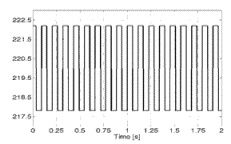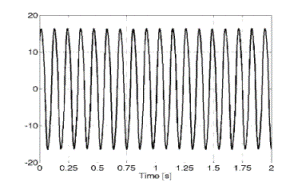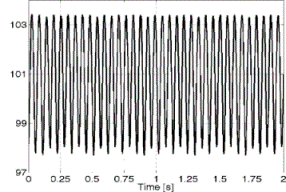Source: XVII IMEKO World Congress Metrology in the 3rd Millennium June 22-27, 2003, Dubrovnik, Croatia
Abstract - The monitoring of power quality (PQ) on supply networks is today an issue of worldwide interest. In this field, one of the most important parameter is the flicker effect, a phenomenon due to luminance fluctuations of the lighting caused by voltage variations. The IEC standardized the implementation of a flickermeter, to supply information about the human reaction to the voltage amplitude modulation [1,2]. Starting from a different flicker measurement approach proposed by the authors [3], in this paper a low-cost smart flicker sensor has been designed and applied. The proposed sensor can transmit data over a TCP-IP network, in order to allow for a remote monitoring of power quality. The performance of the proposed device has been compared with a standard flickermeter and the main experiment results reported.
Keywords: power quality, voltage flicker, signal processing, smart sensors.
1. INTRODUCTION
In recent years the quality of electrical power supply is increasingly becoming a central topic of discussion. In this area of interest one of the most important parameter is related the voltage variations, which produce a physiological irritating phenomenon due to luminance fluctuations of the lighting (light flicker effect) [1,2].
Generally the voltage harmonic distortions do not produce flicker effects, even if in recent years people working in this field have found flicker effects produced by some interharmonic components, which cause a cyclical beat at low frequencies [4].
The measurement of the flicker effect (periodical amplitude modulation of the voltage sinusoidal waveform) according to [1], is implemented with the simulation of the process of physiological visual perception (lamp-eye-brain response), to supply information about the human reaction to the voltage amplitude modulation. The severity level of flicker is evaluated by considering the short time flicker severity index Pst , obtained from the cumulated probability function of the instantaneous perception, for signal acquired for 600 s time intervals.
A different digital approach for the flicker effect evaluation, based on the calculation of the luminous perception function obtained from the acquired r.m.s. voltage waveform, has been proposed by the authors [3]. The main advantages are simpler signal processing and reduced hardware requirements.
Our goal in this paper is to implement this algorithm on a low-cost smart flicker sensor, capable to transmit data over a TCP-IP network, in order to allow for a remote measurement.
The performance of the proposed device has been compared with a reference flickermeter [2] and the main experimental results presented.
2. THE PROPOSED MEASURING APPROACH
The functional and design specifications for the flicker measuring apparatus are reported in the IEC standard [1]. The flickermeter architecture is divided in five parts: i) input voltage adaptor, ii) square law demodulator, iii) weighting filters, iv) squaring and smoothing, v) statistical evaluation of flicker effect. This description refers to an analogue implementation of the first four blocks, while the last block is implemented using a digital processing system.
Our aim in this paper is to propose a low-cost full digital implementation for a flicker measuring device. The proposed approach differs from the straightforward translation of standard flickermeter block tasks to a digital implementation [5,6,7]. We considered the issues of both simplifying the measurement algorithm and reducing the instrument complexity. The proposed measurement approach is based on the consideration that the instantaneous flicker perception function is related to the light intensity changes, produced by the voltage fluctuations to a filament lamp. The flicker sensation variation then depends on the way the r.m.s. voltage waveform changes over time. In this paper we propose the adoption of the following steps for the flicker effect evaluation: i) input voltage transduction, ii) true r.m.s. voltage analog processing, iii) A/D conversion iv) luminous output waveform processing, v) weighting filters, vi) squaring and smoothing, vii) output gain compensation, vii) statistical evaluation of flicker effect.
3. THE DEVELOPED ALGORITHM
The measuring algorithm has been developed for implementation on low-performance microcontrollers [8]. It has been optimised in order to reduce the memory requirement by means of a recursive implementation of the filtering operations. The block diagram of the algorithm is shown in Fig.1.

Fig. 1. Block diagram of the proposed measuring algorithm
As input, a true r.m.s. voltage signal has been adopted (Fig. 2). It is sampled at 450 S/s, without triggering. The acquired data are processed point by point, with an on-line real time procedure.
3.1 Luminous output waveform processing
From the acquired r.m.s. voltage samples, a luminous output waveform is calculated in block 1, by means of the typical parameters of a standard coiled gas-filled 230 V, 60 W lamp. We adopted a constant resistance value of 882 Q and a luminous efficiency value of 12 lumen/watt:


Fig. 2. Rms voltage signal with a 2%, 8.8 Hz rectangular voltage amplitude modulation.
3.2 Filtering
To simulate the nonlinear human visual response to voltage fluctuation signals, we adopted in block 2 a cascade of two second order IIR filters with the following discrete transfer functions, for a sampling rate of 450 S/s:


Fig. 3. Signal filtered by block 2. 3.3 Squaring and smoothing
According to [1], the squaring and smoothing are performed, respectively in blocks 3 and 4, in order to simulate the non-linear eye-brain perception. We implemented a sliding mean averaging of the signal, to simulate the storage effect in the brain. A first order IIR filter with the following discrete transfer functions has been implemented:

3.4 Modulation frequency evaluation and gain compensation
For the IEC flickermeter the overall input-output analogue response of squaring and smoothing, which defines the normalized flickermeter response for sinusoidal and rectangular voltage fluctuations, is given [1].
In block 6 we implemented a procedure to compensate the systematic errors, starting form the calibration parameters measured using a reference flickermeter. It is based on the evaluation of the amplitude modulation frequency of the r.m.s. voltage signal by steps of 2 s (block 5). The adoption of this observation period allows the frequency evaluation in the range 0.5-25 Hz, according to [1]. The frequency evaluation has been implemented using a threshold technique starting from the mean value, calculated by steps of 2 s.
In particular this procedure introduces a gain compensation at the output of block 4, performed with the following equation:

where F is the evaluated frequency and the value of the parameters are:

Fig. 4 shows the proposed instantaneous flicker perception function.

Fig. 4. Proposed instantaneous flicker perception function.
3.5 Statistical evaluation of flicker severity
Flicker severity evaluation requires the processing of the instantaneous flicker perception function, in order to obtain the probability density function. To this aim, we adopted 64 classes. To measure the flicker severity, the short-term flicker evaluation is performed in block 7, using the following formula:

where the percentiles P0j , P1s, P3s, P10s, P50s are the flicker levels exceeded for 0.1; 1; 3; 10 and 50% of the time, during the observation period.
4. THE HARDWARE ARCHITECTURE
The architecture of the proposed smart power quality sensor for the flicker effect evaluation is shown in Fig.5.

Fig.5. Architecture of the proposed smart power quality sensor.
As the voltage input transducer is concerned, a special active attenuator has been developed. It allows i) a nominal input voltage up to 600 Vrms; ii) an overall accuracy of ± 0.3%; iii) a thermal drift <0.1%, iv) a linearity < 0.2% and v) a slew rate of 10 V/us.
The rms voltage measuring circuit is based on the MX536AK true rms-to-dc converter. It offers the following features: i) the rms measurements for both ac and dc signals; ii) a 2 MHz bandwidth for Vrms>1 V; iii) a low supply current of only 1.2 mA; iv) a total error of ±2 mV±0.2% of reading; v) an input signal range from 0 to 7 Vrms with ±15 V supply; vi) an input resistance of 100 MOhm.
The A/D conversion is performed by the Microchip PIC18F452 [8]. This microcontroller is characterized by 32KB internal flash memory, 1.5KB internal RAM memory and a 40 MHz clock. For the statistical valuation of flicker effect an observation period of 600 s is required. For data storage a 512KB external flash memory has been used, with a 1 MHz clock.
The microcontroller performs the following operations:
• continuous sampling of the filtered output fromthe rms-to-dc converter with a rate of 450 S/s, without triggering;
- A/D conversion with a 10-bit resolution;
- on-line processing of acquired raw data;
- data transfer to the external flash memory;
- off-line statistical evaluation of short-term flicker severity;
- data transfer to the web site managing unit;
- communication with an host PC during the apparatus testing.
The layout of the described data acquisition system is shown in Fig.6. The communication with the web site managing unit is carried out by the MAX232 driver. The communication unit is based on the 8051 microcontroller. It carries out the final data processing and performs the results visualization by regenerating HTML pages in the web server. It also performs the control of the TCP/IP communication. JAVA language has been adopted for graphical data representation. Both the measurement software and the web server managing software have developed with the ANSI C.
Fig.7 shows an example of measurement of voltage waveform with sinusoidal amplitude modulation.

Fig.6. Layout of the developed flicker sensor.
5 THE SENSOR CHARACTERIZATION
The characterization of the developed algorithm has been carried out for both sinusoidal and rectangular amplitude modulations, according to [1] standard. The results for the evaluation of normalized response are reported in TABLE I.
We carried out other on-field tests, comparing the overall performance of the implemented instrument with a reference instrument, the Yokogawa WT2030 wattmeter with flicker option [2].
The results, reported in TABLE II, appear to confirm the effectiveness of our implementation, also for this kind of application.

Fig. 7. Measurement of a voltage waveform with sinusoidal amplitude modulation
6. ADVANTAGES OF THE PROPOSED FLICKER SENSOR
The proposed smart sensor for the flicker effect evaluation presents some advantages, compared with a traditional implementation of IEC flickermeter. The proposed hardware architecture allows a simple and fast implementation of different measurement programs, in order to follow the evolution of international standards. The choice of a true rms-to-dc converter permits a simultaneous monitoring of the voltage level that gives more information on the PQ. The first filter of block 3 in [1] is not implemented. This filter is a combination of a high-pass (0.05 Hz) section and a low-pass (35 Hz) section based on a 6th order Butterworth filter and it is not very easy to implement (e.g. stability problems).
TABLE I. Characterization results for the evaluation of a normalized response with sinusoidal and rectangular amplitude voltage fluctuations.

It introduces a delay in the instrument response and cuts off spectral components over 35 Hz, so that the IEC flickermeter can't be adopted for the evaluation of flicker due to interharmonics over 85 Hz [3,4]. The proposed instrument can be adopted for the evaluation of the impact of interharmonic components on the flicker effect in a frequency range up to 175 Hz.
The implemented TCP/IP communication interface allows an easy integration of the sensor into a monitoring power quality system [9]. Furthermore the built-in web server managing unit requires standard internet browsers.
TABLE II. Comparison between short-term flicker severity obtained for a sinusoidal and rectangular voltage fluctuation at 8.8 Hz with a reference and the proposed flickermeters.

7. CONCLUSIONS
In this paper a smart web flicker sensor is proposed. A new measurement approach based on the r.m.s. voltage processing has been developed, to improve the performance with interharmonic components. The smart sensor performs the evaluation of flicker, the data storage and communication via TCP as a web server.
The systems characterization has been performed, with satisfactory results according to the features of the system required by IEC standards.
REFERENCES
[1] EN 61000-4-15, Flickermeter - Functional and design specifications. 1999-04.
[2] EN 61000-3-3, Limitation of voltage fluctuations and flicker in low -voltage supply systems for equipment with rated current 16 A. 1995-01.
[3] G.Bucci, E.Fiorucci, C.Landi "A New Statistical Approach for the Flicker Effect Evaluation", Proc. IEEE PMAPS, Naples, Italy, September 2002.
[4] D.Gallo, R.Langella, A. Testa, "Toward a New Flickermeter Based on Voltage Spectral Analysis", Proc. IEEE International Symposium on Industrial Electronics, L'Aquila, Italy, July 2002.
[5] K. Srinivasan, "Digital Measurement of Voltage Flicker", IEEE Trans. on Power Delivery, Vol.6, n.4, Oct. 1991.
[6] S.Caldara, S.Nuccio, C.Spataro, "A Virtual Instrument for Measurement of Flicker", IEEE Trans. On I&M, Vol.47, n.5, Oct. 1998.
[7] G.Bucci, E.Fiorucci, C.Landi, "Digital Measurement Station for Power Quality Analysis in Distributed Environments", accepted for publication in the February 2003 issue of the IEEE Trans. On I&M.
[8] PICmicro 18C MCUFamily Reference Manual, Microchip Technology Inc., Doc. num. DS39500A, 2000.
[9] G. Bucci, C. Landi, "A Distributed Measurement Architecture for Industrial Applications", accepted for publication in the June 2003 issue of the IEEE Trans. On I&M.